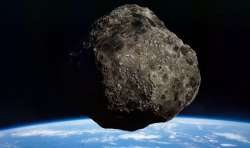Massive asteroid bigger than the London eye approaching Earth
A massive asteroid which is larger than the famous London Eye will be approaching the Earth in just a couple of days. Meanwhile, the National Aeronautics and Space Administration (NASA) has issued a warning for the world over this 'hazardous asteroid'.

A massive asteroid which is larger than the famous London Eye will be approaching the Earth in just a couple of days. Meanwhile, the National Aeronautics and Space Administration (NASA) has issued a warning for the world over this 'hazardous asteroid'.
The space is one and half times the size of the London Eye, which is 135 metres high and will be coming closer to the earth, as reported by Birmingham Live.
US space experts have named the space rock Asteroid 2020 ND and has been branded "potentially hazardous". The monstrous rock measuring 170 metres will come within just 0.034 astronomical units (AU) of our planet on July 24.
One AU (149,598,000 km) is the distance between the Earth and the Sun and it is expected that coming Saturday, the gigantic asteroid which is travelling at a staggering 13.5 kilometres per second - or 48,000 kilometres per hour will be 5,086,327 kilometres away from our planet - a hair's width in astronomical terms.
Warning over its upcoming approach, Birmingham Live quoted the space agency as saying: “Potentially Hazardous Asteroids (PHAs) are currently defined based on parameters that measure the asteroid’s potential to make threatening close approaches to the Earth.”
“Specifically, all asteroids with a minimum orbit intersection distance (MOID) of 0.05 au or less are considered PHAs,” it added further.
Recently, NASA on its Jet Propulsion Laboratory (JPL) website said: “NEOs are comets and asteroids that have been nudged by the gravitational attraction of nearby planets into orbits that allow them to enter the Earth’s neighbourhood. The scientific interest in comets and asteroids is due largely to their status as the relatively unchanged remnant debris from the solar system formation process some 4.6 billion years ago.”
Informing more about the nature of the asteroids, the agency said, “The giant outer planets (Jupiter, Saturn, Uranus, and Neptune) formed from an agglomeration of billions of comets and the leftover bits and pieces from this formation process are the comets we see today. Likewise, today’s asteroids are the bits and pieces left over from the initial agglomeration of the inner planets that include Mercury, Venus, Earth, and Mars.”